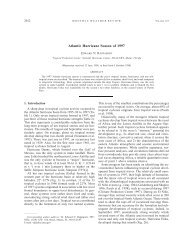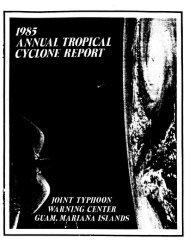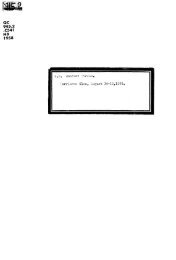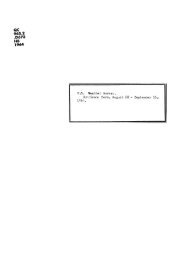Hurricane Gilbert Sept 3-16 1988 - NOAA
Hurricane Gilbert Sept 3-16 1988 - NOAA
Hurricane Gilbert Sept 3-16 1988 - NOAA
You also want an ePaper? Increase the reach of your titles
YUMPU automatically turns print PDFs into web optimized ePapers that Google loves.
National Hu rricane C em<br />
<strong>Gilbert</strong> posed major problems for<br />
meteorologists at NHC. Most objective<br />
hurricane forecast techniques and National<br />
Meteorological Center model guidance consistently<br />
predicted the hurricane to move to<br />
the northwest. A short-wave trough over<br />
the western part of the United States was<br />
expected to be the influencing factor. A<br />
west-northwest movement would bring the<br />
storm into Mexico or onto the relatively unpopulated<br />
lower Texas coast. A turn to the<br />
northwest or north would result in landfall<br />
over the much more densely populated<br />
upper Texas coast. In addition, the storm's<br />
intensity had decreased after its passage<br />
across the northern Yucatan. But the atmospheric<br />
conditions that had produced<br />
175 mph winds and the lowest pressure on<br />
record in the Western Hemisphere were<br />
still in place. A concern was how much intensification<br />
would reoccur before landfall.<br />
While the storm was still east of the<br />
Yucatan peninsula, the NHC forecast track<br />
predicted landfall on the upper Texas coast.<br />
Succeeding forecasts gradually pushed the<br />
track southward. By noon on the 15th <strong>Gilbert</strong><br />
was in the Gulf of Mexico and was still<br />
forecast to hit Texas on the extreme<br />
southern part of the coast near the Mexican<br />
border. At that time, most objective<br />
guidance techniques and many private<br />
meteorologists were still forecasting the<br />
storm to turn north. NHC, however, did<br />
not issue any turn north advisories and <strong>Gilbert</strong><br />
did not turn north until after making<br />
landfall in northern Mexico.<br />
NHC forecasts of hurricane movement<br />
were excellent relative to past performance.<br />
The 24-hour forecast of <strong>Gilbert</strong>, the standard<br />
used to measure forecast error had an<br />
error of only 63 des, while the average 24-<br />
hour error over the past 10 years is 129<br />
miles. Figure 4.1 shows <strong>Gilbert</strong>'s 24-hour<br />
forecast and observed positions during the<br />
life of the storm. Table 4.1 compares the<br />
hurricane's position errors with previous<br />
Y-9<br />
TABLE 4.1<br />
<strong>Hurricane</strong> <strong>Gilbert</strong> Position Errors Versus<br />
Forecast EXTOIS for Previous Years<br />
(Distance measured in statute miles)<br />
Verification data on wind speed forecasts<br />
were not available at the time of this publication.<br />
However, a check of the wind<br />
forecasts from the marine advisories<br />
showed forecasters believed the storm<br />
would intensify from a Category 3 to a<br />
Category 4 after moving off the Yucatan<br />
Peninsula and into the Gulf of Mexico. On<br />
the 15th, maximum sustained winds were<br />
expected to increase from 120 mph to 140<br />
mph. Early on the lath, the forecast called<br />
for an increase to 130 mph. However, the<br />
highest winds remained steady at 120 mph<br />
during <strong>Gilbert</strong>'s passage across the Gulf.<br />
Tide and surge forecasts were excellent for<br />
the Yucatan and Mexico flable 4.2). But<br />
the wording of the tide section in the advisories<br />
caused problems for verification on<br />
the Texas coast.<br />
The 8 AM, <strong>Sept</strong>ember 15, advisory read:<br />
'Tides of 7 to 11 feet above normal may be<br />
expected in the warning area near and to<br />
the north of where the center crosses the<br />
coast. Tides of 4 to 6 feet above normal are<br />
11











